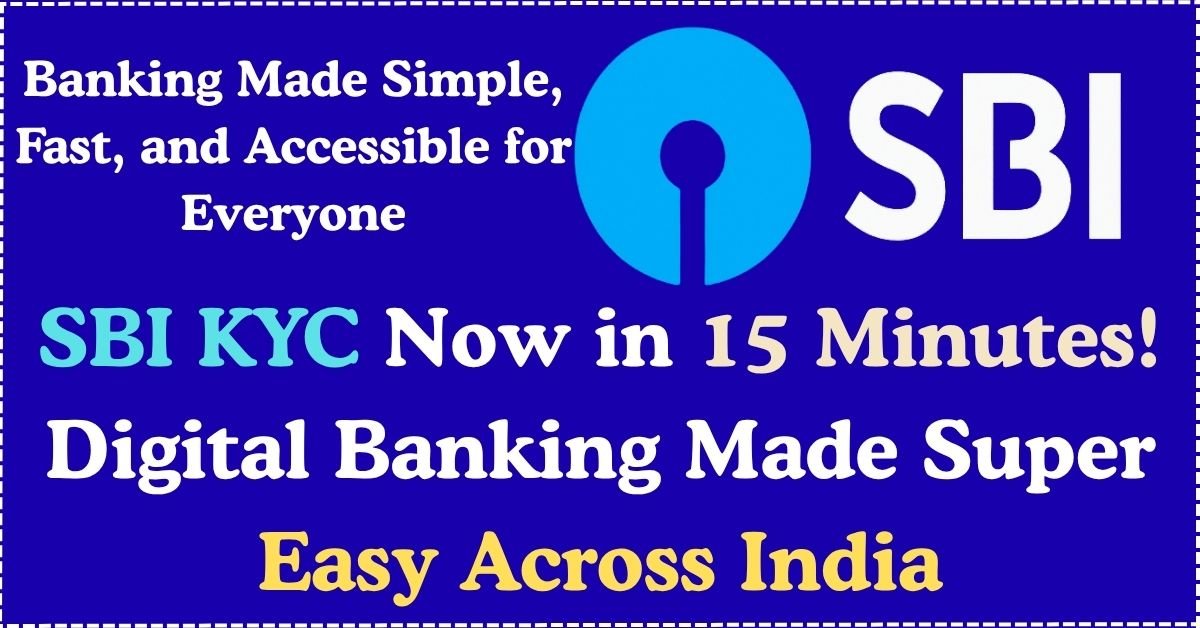SBI KYC: As part of its efforts to make the Know Your Customer (KYC) and re-KYC process easier, State Bank of India (SBI) is one of the oldest financial institutions that have made significant changes to its operations to simplify these processes. These are aimed at making banking more affordable, quicker and easy to the millions of customers that are scattered throughout the whole country. According to a statement by the Chairman CS Setty, this course of simplifying these processes is not only imperative to be able to comply with the regulatory framework, but a promise to provide a slick banking service to all citizens, regardless of their location be it in the metropolitan center or in the rural backyard.
SBI has been able to combine its online activities with a wide-ranging physical network to ensure that people across India have seamless access to banking services. The bank has more than 1.6 lakh touchpoints such as branch offices, business correspondents, and call centres that can serve various needs of its clientele. Interestingly, even its contact centers handle over 60 percent of the rural and semi-urban originated communications through which they provide support in 15 different languages, which help highlight the inclusion orientation by considering financial services in the institution.
With the development of the sophisticated technology, the time spent to onboard a client has been reduced significantly. Previously, the process of a KYC check at a branch took an hour or longer; with modern technologies like e-Aadhaar and the redesigned YONO portal, SBI is now able to accomplish the task in 10-15 minutes. The next release of YONO 2.0 is planned to expand its services to 15 languages and focus on products that satisfy the farmers, MSMEs, and other economically involved customers.
SBI has financial inclusion as one of its strategic visions. With the network of 2.5 million business correspondents, the bank provides 33 banking services in rural, semi-urban and urban locations. The Pradhan Mantri Jan Dhan Yojana (PMJDY) scheme has so far opened 150 million accounts with 99.5 percent being fully funded and 56 percent of which are operated by women hence illustrating the gender-focused nature of finance in the institution. SBI also has the capability of providing loans up to ₹5 crore to small and medium enterprises (SMEs) in just 2526 minutes with the help of its digital infrastructure.
SBI is as well capitalizing on digital credit and acquisition financing models to increase access to financial capital. Finance facilities like Kisan Credit Cards (KCC) can now be provided through UPI and vendor financing facilities can deploy point-of-sale information so as to provide credit on a more effective way. This would help in making sure that individual customers and commercial organizations have quick access to the financial resources needed hence increase in liquidity and growth opportunities.
The approach of the bank is based on holistic and life-cycle oriented approach towards financial management. In its student loans to high-net-worth-offerings, SBI aims to offer end-to-end services that take care of all marks of a customer with regards to their financial journey. Through its heavy-handed security measures, high availability, and enhanced collaboration with fintech companies, SBI has remained at the forefront of digital banking excellence in India.
The issues of the heterogeneity of the population in terms of demographics and territory were also pointed out by the Chairman CS Setty. Having more than 520 million customers, SBI is determined to make sure that there is no single customer who is denied the service regardless of whether they are opening a first account or handling complex investment portfolios. This commitment strengthens the two-pronged obsession with scale and quality at the institution, combining technological revolution, creative approaches and a human touch to provide full banking services.
To sum up, the efforts taken by SBI to simplify the process of KYC, to develop digital solutions like the YONO and expand the financial inclusion programs are bright examples of how the bank is willing to make the customer experience better on a national level. Such undertakings go beyond making the regulatory compliance easier, but also strengthening the financial ecosystem of India, making banking even more accessible, faster, and safer to everyone.
You can also read this
Latest Jobs
Admit Card
Result
- UNIRAJ Result 2025 जारी: BA, B.Sc, B.Ed रिजल्ट लिंक, रोल नंबर से मार्कशीट डाउनलोड करने का आसान तरीका
Scheme
Internship
Sarkari Kaam
Braj Verma is a resident of Rajgarh in Madhya Pradesh and is a content writer and freelancer by profession. He has a degree in Political Science from Barkatullah University, Bhopal. He has expertise in subjects like credit cards, banking, loan, insurance, political analysis and digital marketing.

